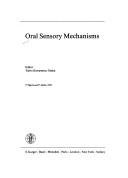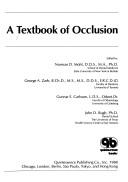
ISBN: 8716111230 Year: 1994 Publisher: Copenhagen : Munksgaard,
Abstract | Keywords | Export | Availability | Bookmark
 Loading...
Loading...Choose an application
- Reference Manager
- EndNote
- RefWorks (Direct export to RefWorks)
Temporomandibular Joint Disorders --- Masticatory Muscles --- Temporomandibular Joint --- Masticatory muscles --- Temporomandibular joint --- Muscles masticateurs --- Articulation temporo-mandibulaire --- physiopathology --- Pathophysiology --- Diseases --- Physiopathologie --- Maladies --- Masticatory muscles. --- Temporomandibular joint. --- Temporomandibular Joint Disorders. --- Temporomandibular Joint. --- physiopathology.

ISBN: 3805512813 Year: 1974 Publisher: Basel, New York : S. Karger
Abstract | Keywords | Export | Availability | Bookmark
 Loading...
Loading...Choose an application
- Reference Manager
- EndNote
- RefWorks (Direct export to RefWorks)
Mastication. --- Masticatory Muscles --- Mastication --- Chewing --- Tooth --- Digestion --- Oral habits --- physiology. --- physiology
Book
ISBN: 9781139526050 1139526057 9781139060851 1139060856 9781139528443 1139528440 1139530720 9781139530729 9781107016224 1107016223 9781139530729 1139540033 110723512X 1283522071 1139527258 9786613834522 1139531913 9781139540032 9781283522076 9781139527255 6613834521 9781139531917 Year: 2012 Publisher: Cambridge, UK Cambridge University Press
Abstract | Keywords | Export | Availability | Bookmark
 Loading...
Loading...Choose an application
- Reference Manager
- EndNote
- RefWorks (Direct export to RefWorks)
Mammalian skull structure is notably diverse; however at a basic level the jaw mechanism is remarkably similar, if not essentially the same, in the majority of mammals. Using simple models that are compared with real animals at every step, this book examines the basic structural features of the mammalian jaw mechanism from a mechanical point of view. It explores how the mechanical constraints placed on the jaw have contributed to the evolution of an efficient basic structure, used by many mammals, which precludes mechanical difficulties and uses a minimum amount of bone tissue. Throughout the book the emphasis is on conceptual understanding, with explanations linked together to form a complete story that can be applied to both fossil and extant mammals. Summarising over forty years of research from one of the leading pioneers in 3D jaw mechanics, this is a must-have for anyone interested in mammalian jaw morphology.
Mammals --- Jaws --- Jaw apparatus --- Masticatory apparatus --- Craniology --- Facial bones --- Head --- Mouth --- Anatomy. --- Mechanical properties.
Dissertation
Year: 1998 Publisher: Groningen Rijksuniversiteit Groningen
Abstract | Keywords | Export | Availability | Bookmark
 Loading...
Loading...Choose an application
- Reference Manager
- EndNote
- RefWorks (Direct export to RefWorks)
Bite Force --- Masticatory Muscles --- Computer Simulation --- Jaw --- Muscle Contraction --- Mastication --- physiology
Book
Abstract | Keywords | Export | Availability | Bookmark
 Loading...
Loading...Choose an application
- Reference Manager
- EndNote
- RefWorks (Direct export to RefWorks)
59.81,1:14.71,6 --- Anatomy --- Lizards --- Masticatory muscles --- Shinisaurus crocodilurus --- Xenosaurus grandis --- Classification
Dissertation
Year: 1995 Publisher: Liège : Université de Liège. Faculté de médecine (ULg). Département de clinique et pathologie médicales,
Abstract | Keywords | Export | Availability | Bookmark
 Loading...
Loading...Choose an application
- Reference Manager
- EndNote
- RefWorks (Direct export to RefWorks)
STOMATOGNATHIC SYSTEM --- MASTICATORY MUSCLES --- POSTURE --- EQUILIBRIUM (PHYSICS) --- MUSCLES --- TRANSCUTANEOUS ELECTRIC NERVE STIMULATION --- PHYSIOLOGY
Book
ISBN: 9782843614606 Year: 2024 Publisher: [Paris] : Éditions CdP,
Abstract | Keywords | Export | Availability | Bookmark
 Loading...
Loading...Choose an application
- Reference Manager
- EndNote
- RefWorks (Direct export to RefWorks)
Longtemps considérée comme une terra incognita pour de nombreux chirurgiens-dentistes, l’occlusodontologie a récemment progressé grâce à une meilleure compréhension des processus douloureux et des dysfonctions temporo-mandibulaires. Cet ouvrage ajoute une pierre à l’édifice en abordant de manière didactique la physiologie neuro-musculaire essentielle à la compréhension de la dysocclusion. La démarche proposée, éclairée par la littérature scientifique, permettra aux chirurgiens-dentistes de répondre à plusieurs objectifs cliniques et thérapeutiques : explorer les liens entre occlusion et posture ; réaliser un bilan occlusal incluant l’électromyographie de surface, l’enregistrement électronique de la cinématique mandibulaire et l’utilisation d’une plateforme de stabilométrie ; poser un diagnostic occlusal en tenant compte de données neuro-musculaires et cinématiques ; mener un traitement occlusal rigoureux au sein d’une approche multidisciplinaire et d’une démarche en rééducation fonctionnelle.
Occlusion (Dentistry) --- Temporomandibular joint. --- Masticatory muscles. --- Dental Occlusion. --- Temporomandibular Joint. --- Temporomandibular Joint Disorders. --- Posture. --- Masticatory Muscles. --- Occlusion dentaire. --- Articulation temporo-mandibulaire --- Appareil manducateur --- Troubles de l'articulation temporomandibulaire. --- Muscles masticateurs. --- Réadaptation. --- Malocclusion --- Orthodontics --- Occlusion dentaire --- Malocclusion dentaire

ISBN: 0867151676 Year: 1991 Publisher: Chicago : Quintessence Pub. Co.,
Abstract | Keywords | Export | Availability | Bookmark
 Loading...
Loading...Choose an application
- Reference Manager
- EndNote
- RefWorks (Direct export to RefWorks)
Dental Occlusion --- Malocclusion --- Stomatognathic System --- Temporomandibular Joint Diseases --- Occlusion (Dentistry) --- Occlusion dentaire --- diagnosis --- therapy --- Dental Occlusion. --- Stomatognathic System. --- Temporomandibular Joint Disorders --- Dental occlusion --- Teeth --- Dentistry --- Orthodontics --- Prognathism --- Masticatory System --- Masticatory Systems --- Stomatognathic Systems --- System, Masticatory --- System, Stomatognathic --- Systems, Masticatory --- Systems, Stomatognathic --- Occlusion, Dental --- Canine Guidance --- Occlusal Guidance --- Occlusal Plane --- Dental Occlusions --- Guidance, Canine --- Guidance, Occlusal --- Occlusal Guidances --- Occlusal Planes --- Occlusions, Dental --- Plane, Occlusal --- Planes, Occlusal --- diagnosis. --- therapy. --- Occlusion --- Abnormalities --- Malocclusion. --- Occlusion (Dentistry). --- Dental Arch
Book
Abstract | Keywords | Export | Availability | Bookmark
 Loading...
Loading...Choose an application
- Reference Manager
- EndNote
- RefWorks (Direct export to RefWorks)
Ankylosaurus --- Dinosaurs --- Jaws --- Mandibular ramus --- Masticatory muscles --- Paleontology --- Reptiles, Fossil --- Alberta --- Red Deer River (Alta. and Sask.)
Book
ISBN: 1503606465 9781503606463 9781503604131 1503604136 Year: 2018 Publisher: Stanford, California
Abstract | Keywords | Export | Availability | Bookmark
 Loading...
Loading...Choose an application
- Reference Manager
- EndNote
- RefWorks (Direct export to RefWorks)
There's a silent epidemic in western civilization, and it is right under our noses. Our jaws are getting smaller and our teeth crooked and crowded, creating not only aesthetic challenges but also difficulties with breathing. Modern orthodontics has persuaded us that braces and oral devices can correct these problems. While teeth can certainly be straightened, what about the underlying causes of this rapid shift in oral evolution and the health risks posed by obstructed airways? Sandra Kahn and Paul R. Ehrlich, a pioneering orthodontist and a world-renowned evolutionist, respectively, present the biological, dietary, and cultural changes that have driven us toward this major health challenge. They propose simple adjustments that can alleviate this developing crisis, as well as a major alternative to orthodontics that promises more significant long-term relief. Jaws will change your life. Every parent should read this book.
Jaws --- Malocclusion. --- Occlusion (Dentistry) --- Orthodontics --- Teeth --- Prognathism --- Jaw apparatus --- Masticatory apparatus --- Craniology --- Facial bones --- Head --- Mouth --- Health aspects. --- Abnormalities. --- Abnormalities --- Abnormities and deformities

 Search
Search Feedback
Feedback About UniCat
About UniCat  Help
Help News
News